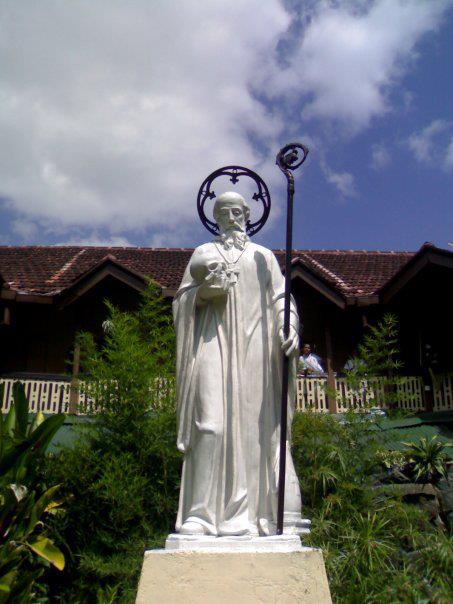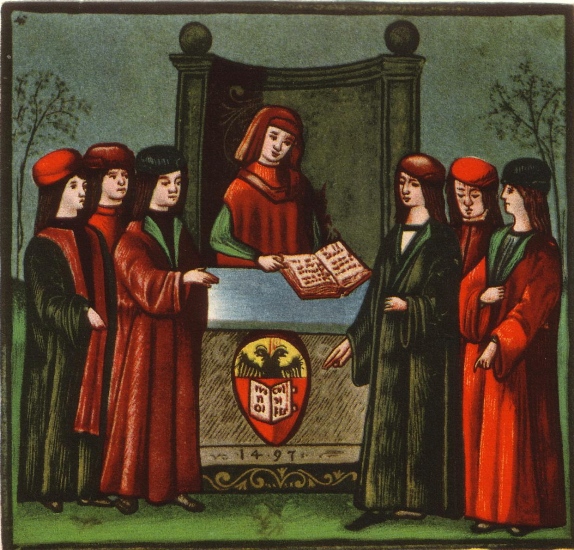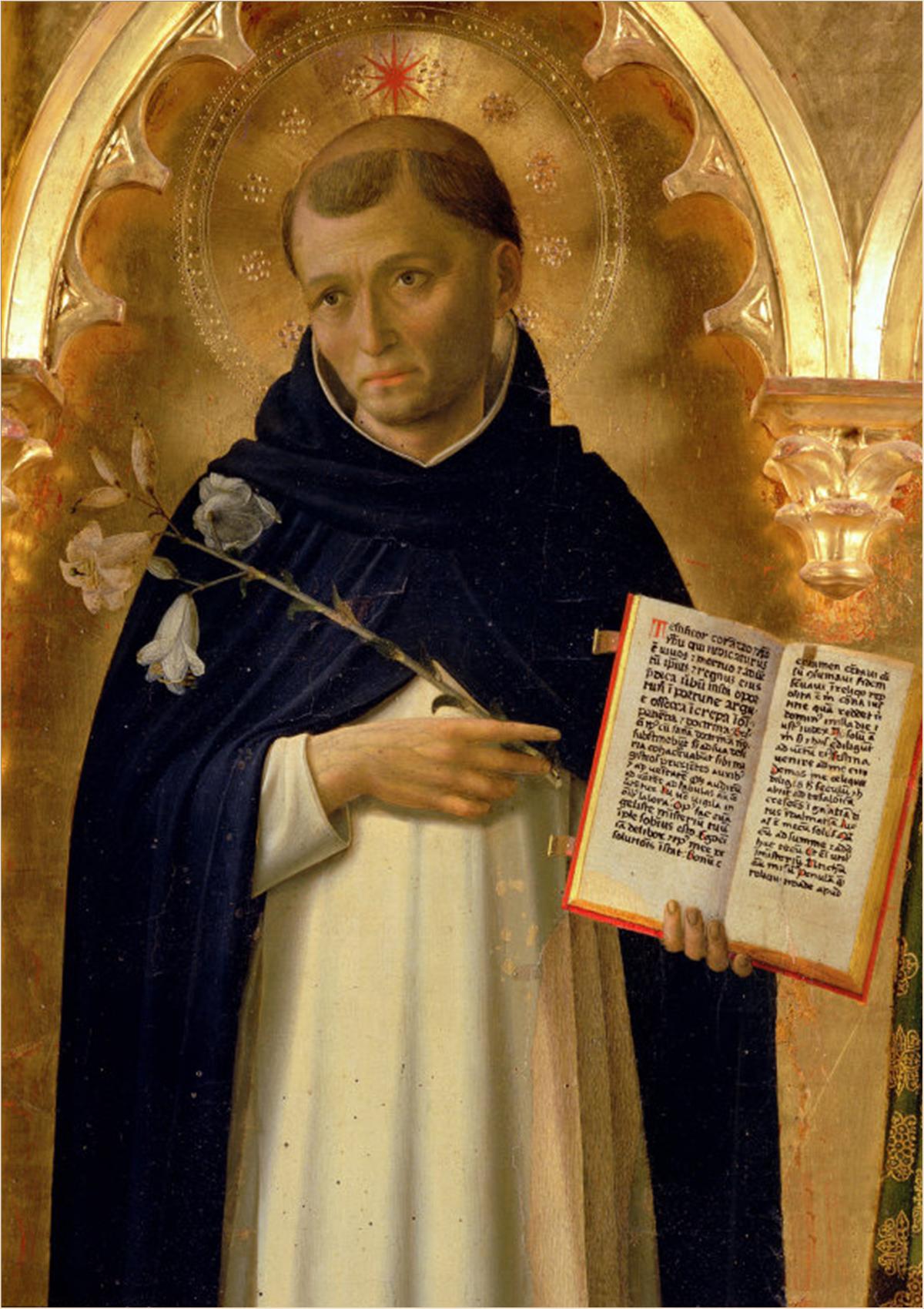|
Sylvester Gozzolini
Silvestro Guzzolini (1177 – 26 November 1267) was an Italian Catholic priest and the founder of the Silvestrini. He served as a canon in Osimo but respectful rebukes of his bishop's inappropriate conduct led him to leave for a hermitage before the bishop could strip him of his position. He remained in his hermitage with a determination to found a religious congregation and based it upon the Order of Saint Benedict after having a dream of Benedict of Nursia. His order received papal approval from Pope Innocent IV which allowed his order to expand across Italian cities to a significant degree. His beatification was confirmed in the 1260s after his death in 1267, and he was later canonized in 1598 as a saint. Life Silvestro Guzzolini was born to Gislerio and Bianca Guzzolini in Osimo. He was sent in 1197 to learn jurisprudence in the college at Bologna, for law, and the college in Padua. Finding no satisfaction in his studies and deeming them too secular, he felt called to ... [...More Info...] [...Related Items...] OR: [Wikipedia] [Google] [Baidu] |
Catholic Church
The Catholic Church, also known as the Roman Catholic Church, is the largest Christian church, with 1.3 billion baptized Catholics worldwide . It is among the world's oldest and largest international institutions, and has played a prominent role in the history and development of Western civilization. O'Collins, p. v (preface). The church consists of 24 ''sui iuris'' churches, including the Latin Church and 23 Eastern Catholic Churches, which comprise almost 3,500 dioceses and eparchies located around the world. The pope, who is the bishop of Rome, is the chief pastor of the church. The bishopric of Rome, known as the Holy See, is the central governing authority of the church. The administrative body of the Holy See, the Roman Curia, has its principal offices in Vatican City, a small enclave of the Italian city of Rome, of which the pope is head of state. The core beliefs of Catholicism are found in the Nicene Creed. The Catholic Church teaches that it ... [...More Info...] [...Related Items...] OR: [Wikipedia] [Google] [Baidu] |
University Of Bologna
The University of Bologna ( it, Alma Mater Studiorum – Università di Bologna, UNIBO) is a public research university in Bologna, Italy. Founded in 1088 by an organised guild of students (''studiorum''), it is the oldest university in continuous operation in the world, and the first degree-awarding institution of higher learning. At its foundation, the word ''universitas'' was first coined.Hunt Janin: "The university in medieval life, 1179–1499", McFarland, 2008, , p. 55f.de Ridder-Symoens, Hilde''A History of the University in Europe: Volume 1, Universities in the Middle Ages'' Cambridge University Press, 1992, , pp. 47–55 With over 90,000 students, it is the second largest university in Italy after La Sapienza in Rome. It was the first place of study to use the term ''universitas'' for the corporations of students and masters, which came to define the institution (especially its law school) located in Bologna. The university's emblem carries the motto, ''Alma Mater Studio ... [...More Info...] [...Related Items...] OR: [Wikipedia] [Google] [Baidu] |
Montefano
Montefano is a ''comune'' (municipality) in the Province of Macerata in the Italian region Marche, located about southwest of Ancona and about north of Macerata. Montefano borders the following municipalities: Appignano, Filottrano, Montecassiano, Osimo, Recanati. Sights Churches in Montefano include: * Collegiata di San Donato, Baroque style *Santa Maria Assunta * San Filippo Benizi, also in Baroque style. People * Marcello Cervini degli Spannochi, Pope Marcellus II Pope Marcellus II ( it, Marcello II; 6 May 1501 – 1 May 1555), born Marcello Cervini degli Spannocchi, was a Papalini Catholic prelate who served as head of the Catholic Church and ruler of the Papal States from 9 April 1555 until h ..., was born in Montefano. References External links Official website Cities and towns in the Marche {{Marche-geo-stub ... [...More Info...] [...Related Items...] OR: [Wikipedia] [Google] [Baidu] |
Order Of Preachers
The Order of Preachers ( la, Ordo Praedicatorum) abbreviated OP, also known as the Dominicans, is a Catholic mendicant order of Pontifical Right for men founded in Toulouse, France, by the Spanish priest, saint and mystic Dominic of Caleruega. It was approved by Pope Honorius III via the papal bull '' Religiosam vitam'' on 22 December 1216. Members of the order, who are referred to as ''Dominicans'', generally carry the letters ''OP'' after their names, standing for ''Ordinis Praedicatorum'', meaning ''of the Order of Preachers''. Membership in the order includes friars, nuns, active sisters, and lay or secular Dominicans (formerly known as tertiaries). More recently there has been a growing number of associates of the religious sisters who are unrelated to the tertiaries. Founded to preach the Gospel and to oppose heresy, the teaching activity of the order and its scholastic organisation placed the Preachers in the forefront of the intellectual life of the Middle ... [...More Info...] [...Related Items...] OR: [Wikipedia] [Google] [Baidu] |
Pope Gregory IX
Pope Gregory IX ( la, Gregorius IX; born Ugolino di Conti; c. 1145 or before 1170 – 22 August 1241) was head of the Catholic Church and ruler of the Papal States from 19 March 1227 until his death in 1241. He is known for issuing the '' Decretales'' and instituting the Papal Inquisition, in response to the failures of the episcopal inquisitions established during the time of Pope Lucius III, by means of the papal bull '' Ad abolendam'', issued in 1184. The successor of Honorius III, he fully inherited the traditions of Gregory VII and of his own cousin Innocent III and zealously continued their policy of papal supremacy. Early life Ugolino (Hugh) was born in Anagni. The date of his birth varies in sources between c. 1145 and 1170. He received his education at the Universities of Paris and Bologna. He was created Cardinal-Deacon of the church of Sant'Eustachio by his cousin Innocent III in December 1198. In 1206 he was promoted to the rank of Cardinal Bishop of Osti ... [...More Info...] [...Related Items...] OR: [Wikipedia] [Google] [Baidu] |
Filottrano
Filottrano is a ''comune'' (municipality) in the Province of Ancona in the Italian region Marche, located about southwest of Ancona. Filottrano borders the following municipalities: Appignano, Cingoli, Jesi, Montefano, Osimo, Santa Maria Nuova. Lardini Lardini Srl is an Italian fashion house founded in 1978 by then 18-year-old Luigi Lardini, his 21-year-old brother Andrea Lardini and 19-year-old sister Lorena Lardini. History The company was founded by the Lardini family in 1978 in Filottran ..., the international fashion company, is based in Filottrano. References External links Official website Cities and towns in the Marche {{Marche-geo-stub ... [...More Info...] [...Related Items...] OR: [Wikipedia] [Google] [Baidu] |
Bonfilius
:''"Saint Bonfilius" can also refer to Buonfiglio dei Monaldi, one of the founders of the Servite Order.'' Bonfilius (c. 1040 – c. 1125) was an Italian saint, monk and bishop. He was born in Osimo, close to Ancona, and entered the Benedictine monastery of Santa Maria di Storaco, close to Filottrano, as a monk. There, although being the youngest of the monastery, he was known as the most knowledgable in scripture in the congregation and was elected abbot of the monastery. Between 1072 and 1078, he was elected bishop of Foligno. Bonfilius made a donation to the canons of the church of Folignano in 1078 and was encouraging Mainardo in the foundation of the abbey of Sassovivo in 1080. In 1096 he fulfilled his wish to go to the Holy Land and joined the forces of the First Crusade on pilgrimage. On the way to the Holy Land, his companions that he had come with died one by one and he reached Jerusalem by himself. There, he lift as a hermit until 1104 when he returned to Italy. A ... [...More Info...] [...Related Items...] OR: [Wikipedia] [Google] [Baidu] |
Religious Order
A religious order is a lineage of communities and organizations of people who live in some way set apart from society in accordance with their specific religious devotion, usually characterized by the principles of its founder's religious practice. It is usually composed of laypeople and, in some orders, clergy. Such orders exist in many of the world's religions. Buddhism In Buddhist societies, a religious order is one of the number of monastic orders of monks and nuns, many of which follow a certain school of teaching—such as Thailand's Dhammayuttika order, a monastic order founded by King Mongkut (Rama IV). A well-known Chinese Buddhist order is the ancient Shaolin order in Ch'an (Zen) Buddhism; and in modern times, the Order of Hsu Yun. Christianity Catholic tradition A Catholic religious institute is a society whose members (referred to as "religious") pronounce vows that are accepted by a superior in the name of the Catholic Church, who wear a religious habit a ... [...More Info...] [...Related Items...] OR: [Wikipedia] [Google] [Baidu] |
Convent
A convent is a community of monks, nuns, religious brothers or, sisters or priests. Alternatively, ''convent'' means the building used by the community. The word is particularly used in the Catholic Church, Lutheran churches, and the Anglican Communion. Etymology and usage The term ''convent'' derives via Old French from Latin ''conventus'', perfect participle of the verb ''convenio'', meaning "to convene, to come together". It was first used in this sense when the eremitical life began to be combined with the cenobitical. The original reference was to the gathering of mendicants who spent much of their time travelling. Technically, a monastery is a secluded community of monastics, whereas a friary or convent is a community of mendicants (which, by contrast, might be located in a city), and a canonry is a community of canons regular. The terms abbey and priory can be applied to both monasteries and canonries; an abbey is headed by an abbot, and a priory is a lesser de ... [...More Info...] [...Related Items...] OR: [Wikipedia] [Google] [Baidu] |
Holy Orders In The Catholic Church
The sacrament of holy orders in the Catholic Church includes three orders: bishops, priests, and deacons, in decreasing order of rank, collectively comprising the clergy. In the phrase "holy orders", the word "holy" means "set apart for a sacred purpose". The word "order" designates an established civil body or corporation with a hierarchy, and ordination means legal incorporation into an order. In context, therefore, a group with a hierarchical structure that is set apart for ministry in the Church. Deacons, whether transitional or permanent, receive faculties to preach, to perform baptisms, and to witness marriages (either assisting the priest at the Mass, or officiating at a wedding not involving a Mass). They may assist at services where Holy Communion is given, such as the Mass, and they are considered the ordinary dispenser of the Precious Blood (the wine) when Communion is given in both types and a deacon is present, but they may not celebrate the Mass. They may officiat ... [...More Info...] [...Related Items...] OR: [Wikipedia] [Google] [Baidu] |
Holy Scripture
Religious texts, including scripture, are texts which various religions consider to be of central importance to their religious tradition. They differ from literature by being a compilation or discussion of beliefs, mythologies, ritual practices, commandments or laws, ethical conduct, spiritual aspirations, and for creating or fostering a religious community. The relative authority of religious texts develops over time and is derived from the ratification, enforcement, and its use across generations. Some religious texts are accepted or categorized as canonical, some non-canonical, and others extracanonical, semi-canonical, deutero-canonical, pre-canonical or post-canonical. "Scripture" (or "scriptures") is a subset of religious texts considered to be "especially authoritative", revered and "holy writ", "sacred, canonical", or of "supreme authority, special status" to a religious community. The terms ''sacred text'' and ''religious text'' are not necessarily interchangeable i ... [...More Info...] [...Related Items...] OR: [Wikipedia] [Google] [Baidu] |
Theology
Theology is the systematic study of the nature of the divine and, more broadly, of religious belief. It is taught as an academic discipline, typically in universities and seminaries. It occupies itself with the unique content of analyzing the supernatural, but also deals with religious epistemology, asks and seeks to answer the question of revelation. Revelation pertains to the acceptance of God, gods, or deities, as not only transcendent or above the natural world, but also willing and able to interact with the natural world and, in particular, to reveal themselves to humankind. While theology has turned into a secular field , religious adherents still consider theology to be a discipline that helps them live and understand concepts such as life and love and that helps them lead lives of obedience to the deities they follow or worship. Theologians use various forms of analysis and argument ( experiential, philosophical, ethnographic, historical, and others) to help u ... [...More Info...] [...Related Items...] OR: [Wikipedia] [Google] [Baidu] |

.jpg)





